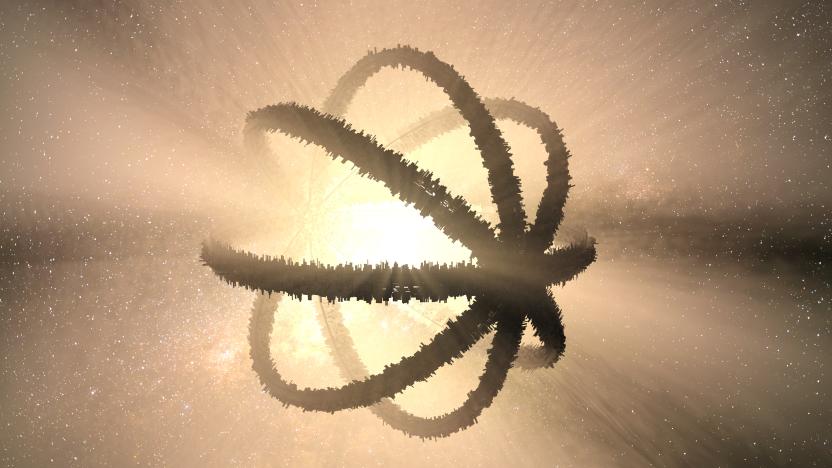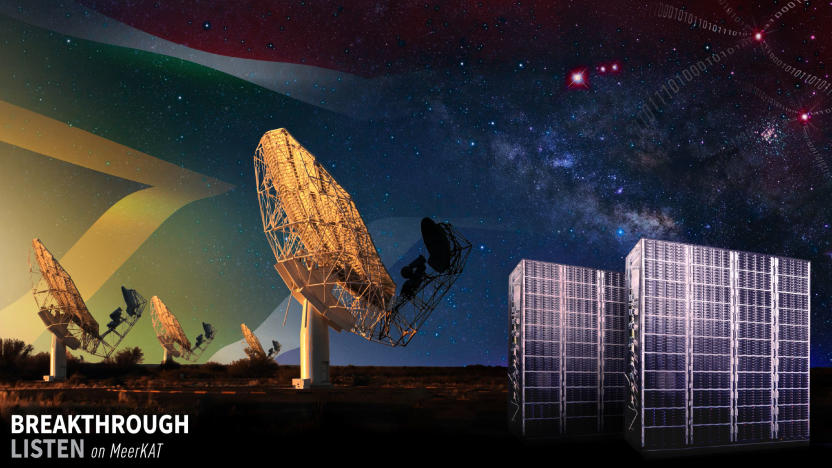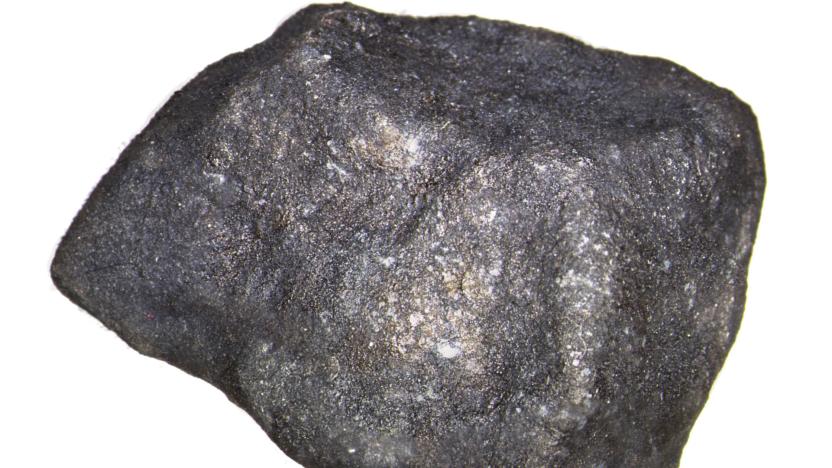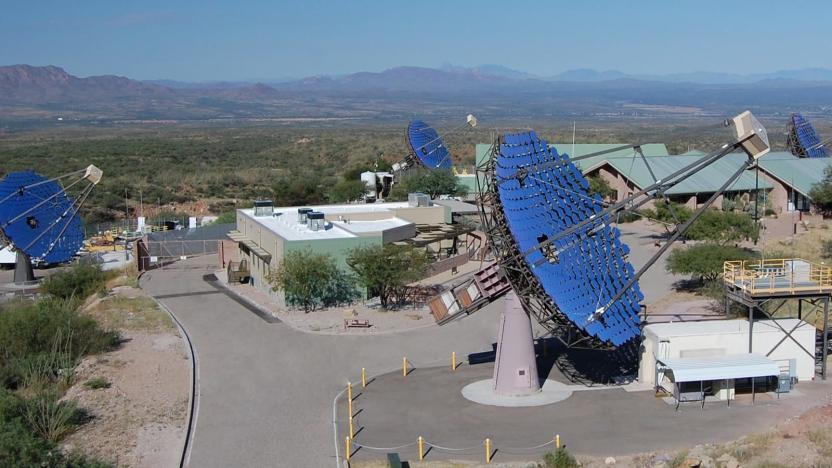extraterrestrial
Latest

Hitting the Books: We'd likely have to liquidate Jupiter to build a Dyson Sphere around the Sun
In "The Possibility of Life," science journalist Jaime Green examines humanity's intriguing history of looking to the stars and finding ourselves reflected in them.

Southern hemisphere’s largest radio telescope joins search for extraterrestrial tech
The Breakthrough Listen project will now be able to search more than a million stars within two years as it searches for signs of intelligent extraterrestrial life.

'Pristine' meteorite may provide clues to the origins of our solar system
A meteorite that lit up the night sky in Michigan in 2018 contains ‘pristine’ organic compounds that offer clues to how life formed on Earth, according to researchers.

Breakthrough searches for signs of alien life in ultra-fast light pulses
Internet investor Yuri Milner's search for extraterrestrial life now includes a hunt for, effectively, interstellar Morse code. Breakthrough Listen is teaming with the partners behind VERITAS (the Very Energetic Radiation Imaging Telescope Array System) to search for nanoseconds-long optical pulses that could indicate the presence of aliens trying to flash messages across the cosmos. The collaboration will use all four telescopes at once to check for these light-based "beacons," which would could be brighter than stars observed in the same direction.

Saturn and Jupiter's moon burps bode well for distant life
Scientists recently took a closer look at data over a decade old and concluded that two moons orbiting Saturn and Jupiter might have environments that foster life. During an October 2015 flyby of the ringed planet's moon Enceladus, the probe Cassini was hit by gaseous plume, which was likely a hydrothermal vent breaking through the iced surface. Scientists theorize that the spray is evidence of chemical energy for life to feed on. Thanks to sporadic evidence of plumes on Jupiter's moon Europa, NASA has announced that two locations in the solar system might support living organisms.

SETI's 'unusual signal' most likely came from Earth
With apologies to the would-be Dr. Ellie Arroways out there: the "unusual signal" picked up by SETI using Russia's RATAN–600 radio telescope and thought to be originating from a star in the Hercules constellation is almost certainly coming from Earth and not some advanced alien civilization. In a statement the Special Astrophysical Observatory of the Russian Academy of Sciences wrote: "Subsequent processing and analysis of the signal revealed its most probable terrestrial origin."

SETI researchers investigate an unusual signal
The hunt for alien life might have turned up something special. A Search for Extraterrestrial Intelligence team using Russia's RATAN-600 radio telecope (above) is investigating an unusually strong signal from a star 95 light years away, in the Hercules constellation. It's far from conclusive evidence of sentient beings. However, it's interesting enough that team members have called for "permanent monitoring" of their target, and have managed to get help from both the Allen Telescope Array in California as well as Panama's Boquete Optical Observatory.

NASA's chemical 'laptop' would help find life on other planets
Planetary rovers can already find potential signs of life, but they're not really meant to find life itself. NASA may have just the device to find that concrete evidence, though. Its newly tested Chemical Laptop is the first device built to detect amino acids and fatty acids (the telltale signs of life as we know it) on other worlds. The battery-powered device needs liquid samples to work, but it has a coffee machine-like mechanism that uses hot water to get the organic material out.

Astronomers find pure oxygen leaking from Rosetta's comet
European Space Agency astronomers, with the help of the Rosetta spacecraft, have made a remarkable discovery that could fundamentally alter our understanding of how the solar system formed. They have detected large amounts of pure oxygen (O2) leaking from comet 67P/Churyumov-Gerasimenko. Oxygen is a pretty common element, but because it reacts so easily with other elements it's almost always found in mixed molecules like carbon monoxide (CO), carbon dioxide (CO2) or water (H2O).

Internet investor pours $100 million into the search for alien life
The hunt for extraterrestrial life just got a big leg up. Internet investor Yuri Milner and his Breakthrough Prize Foundation will spend $100 million supporting Breakthrough Listen, a project that will use radio telescopes, lasers and other equipment to search for alien signals. The cash will not only guarantee equipment time, but lead to dedicated processing equipment that could dramatically improve the discovery process. Researchers should not only cover several times more sky and radio wavelengths, but inspect both in greater detail and at higher speeds -- the radio telescope searches should run 100 times faster, even as they tackle five times as many wavelengths.

The building blocks of life found orbiting another star
Looks like NASA's Chief Scientist Ellen Stofan may have over-estimated how long it would take to find extraterrestrial organisms. For the first time in the history of astronomy, scientists have discovered two complex organic molecules, which is vital to the formation of life as we know it, outside of our solar system. Researchers at the Harvard-Smithsonian Center for Astrophysics in Cambridge, Massachusetts actually found three forms of cyanide -- specifically hydrogen cyanide (HCN), methyl cyanide (CH3CN), and cyanoacetylene (HC3N) -- circling a star known as MWC 480. These are the same sorts of chemicals (and in the same concentrations!) that were present in comets orbiting our own solar system back when life here got its start. And while cyanide is super-duper toxic to living organisms, it's absolutely necessary for life's formation. In short, this discovery is a huge deal because it means that the seeds of life aren't confined to Sol alone.

NASA thinks we'll find signs of extraterrestrial life in 20 years
The quest to find proof of life beyond Earth hasn't been without its setbacks, but NASA isn't deterred. If anything, it's optimistic -- Chief Scientist Ellen Stofan now claims that there will be "definitive evidence" of extraterrestrial life within the next 10 to 20 years. Given the sheer number of oceans within just our solar system, she argues, it's "not an if, it's a when." The more pressing questions are what kind of life we'll find, and how we'll find it. It'll most likely involve a probe or rover detecting microscopic organisms rather than a close encounter of the third kind, so there probably won't be much drama involved. Still, the very fact that we could find alien species within our lifetimes is exciting. [Image credit: Lynette Cook, NASA]

Motion-detecting nanosensors could help find life on other planets
Much as we'd love to discover grey aliens with warp drive technology, any extraterrestrial life we're lucky enough to find will likely be pretty basic. But the chemical detection methods used by space probes like Curiosity or Philae are hit-and-miss -- they can't actually tell if something is alive or not. Scientists in France have developed a new nanosensor that may help: a simple cantilever with a laser motion sensor that can accept about 500 bacteria. As long as they're alive, the cells will cause minute vibrations on the cantilever, which are captured by the lasers as a sign of life. After scientists kill the cells, the signals stop.

Research says alien life could exist but chances of contact are slim
It's incredibly likely that we aren't alone in the universe, but the chances of us making contact with extra-terrestrials aren't nearly as high. Astrobiologist Amri Wandel seeks to expand on the Drake equation (a formula used to encapsulate the variables scientists looking for E.T.s should consider) by factoring in some of the recent Kepler data. According to Wandel's research (PDF), there are possibly billions of life-sustaining planets in the galaxy, but planets where organisms could exist and planets where life does exist are two different things. These findings come from an advance-release of the International Journal of Astrobiology that should see publication next year.

Alt-week 8.11.12: Robo-billies, quasicrystals and radioactive art
Alt-week peels back the covers on some of the more curious sci-tech stories from the last seven days. It's not like we're trying to out-weird ourselves, it just, somehow, keeps happening. At least one of this week's offerings (we'll leave it to you to figure out which) will possibly be the creepiest thing we post all year. As for the rest, well it's slightly more palatable. We'll get uncharacteristically pumped about cycling, meet some extra-terrestrial quasicrystals and enjoy some art with X-men credentials. This is alt-week.

ThinkGeek's Mark VII Sonic Screwdriver universal remote pleases Whovians in time for Comic-Con
Ever wished you too could make use of the awesome powers that lie within Dr. Matt Smith's Mark VII Sonic Screwdriver? Well, it's still not exactly a reality in the way of the space-bred handyman's gadget seen on Doctor Who, but ThinkGeek and The Wand Company have you covered if an IR-packing replica universal remote sounds good enough. This BBC-licensed Mark VII remote handles up to 39 commands that are all controlled using 13 different motion gestures. Of course, if controlling the likes of TV and AV devices in an extraterrestrial fashion just isn't your thing, there's always ThinkGeek's Sonic Screwdriver flashlight, right? There's no word on price just yet, but San Diego Comic-Con attendees can try it out first-hand at the BBC America Booth (#3629) starting July 12. The Mark VII remote is set to go sale for $99 at ThinkGeek's website on August 31st, so for now we'll direct you to the press release after the break. Update: Video demo added after the break. [Thanks, Alan]

New super-Earth detected, 'best candidate' for supporting life
A new potentially life-bearing "super-Earth" has been discovered orbiting a relatively nearby star. Described as the "best candidate" for supporting liquid water -- and therefore life -- the planet (GJ 667Cc) is believed to be about 4.5 times the size of Earth. The parent star (GJ 667C) is 22 light years away, and this is the second potentially Earth-like rock scientists have discovered orbiting the M-class dwarf. With a 28.15 day cycle, it's calculated to receive 90 percent as much light as Earth, and much of that is infrared (meaning the actual energy delivered is about equal) -- crucially hinting at similar temperatures and favorable conditions. Not enough is known about the atmosphere right now to fully nail the water prospects, but it's still our best hope of discovering life as we (don't) know it yet.

SETI comes back from the financial dead, gets a check from Jodie Foster
Roswell devotees, dry those tears -- the search for alien overlords frenemies is back on. Four months after going into financial "hibernation," SETI's Allen Telescope Array has been temporarily resuscitated thanks to an infusion of publicly raised funds from the SETIStars program, and Ms. Jodie Foster. The web campaign for those-who-believe raised over $200,000 in just 45 days, enough cash to get the Paul Allen-funded dishes scanning the skies for at least five more months. Tom Pierson, the institute's CEO, is hoping to secure long-term funding for the project from the U.S. Air Force, which could use the array during the daytime "to track orbital objects that otherwise might pose a threat to the International Space Station and other satellites." However Pierson manages to keep the fleet of skyward-facing ears afloat, one thing's for sure -- the truth is out there and tracking it's a hustle.

NASA finds DNA components in meteorites, says they originated in space (video)
So, this is kinda wild: scientists at NASA have uncovered new evidence that DNA components found in meteorites can originate in space, lending new credence to the theory that life on Earth may have arisen from a pre-existing "kit" of materials delivered via asteroid. The discovery is outlined in a new paper from Dr. Michael Callahan, whose team of researchers closely analyzed samples from 12 different meteorites, using a mass spectrometer and liquid chromatography. In their samples, they found traces of adenine, guanine, and a variety of molecules known as nucleobase analogs -- including three that are rarely found on Earth. Scientists have long known that meteorites can contain DNA elements, but were unsure whether these materials actually originate in space. The presence of these three molecules, however, suggest that they do, potentially raising new questions about the dawn of life on Earth, and beyond. It's all quite heady, but steam ahead for a NASA video that might help clarify things, after the break.

SETI suspends search for alien life, E.T. weeps in the silent dark of space
Our progress toward intergalactic fellowship has suffered another blow, as SETI suspended operations of its Allen Telescope Array. Funded by Microsoft co-founder Paul Allen, the array is a collection of radio dishes that scan the skies for signs of life; now it'll be in "hibernation" mode until 2013, when the institute's new round of funding begins. SETI hopes to raise $5 million to bring the Array back online before then, while it continues to use other telescopes around the world, including the Hubble Space Telescope. The budget woes are especially bitter given the number of recently identified alien planets – NASA's Kepler mission found 1,235. If any of them are broadcasting the next Wow! signal, let's hope it doesn't fall on deaf earthling ears.










